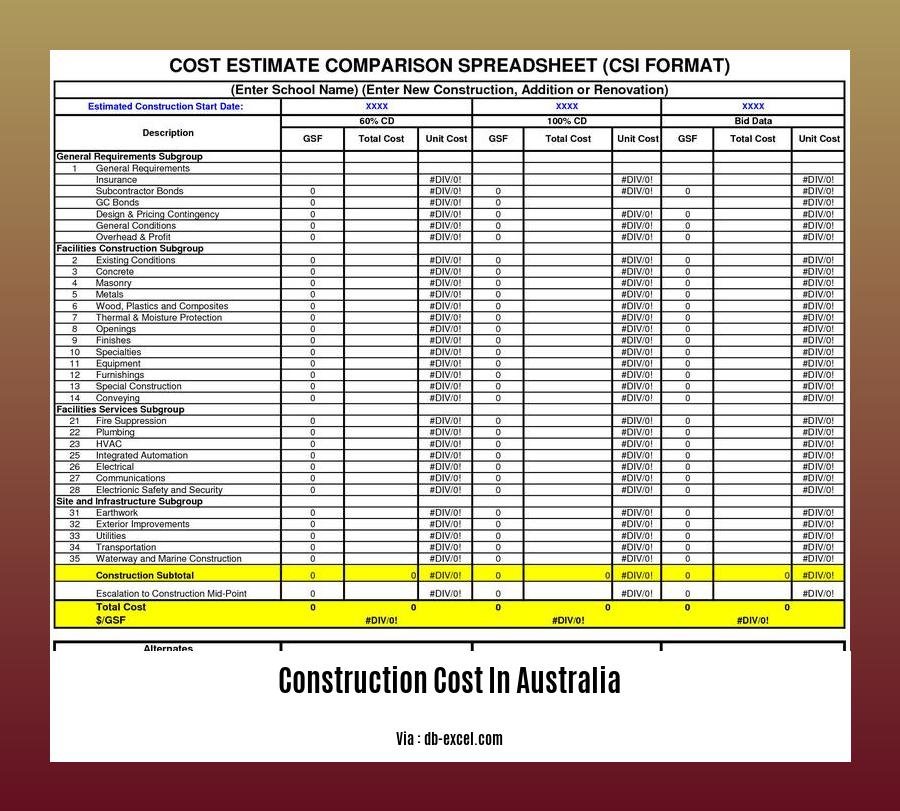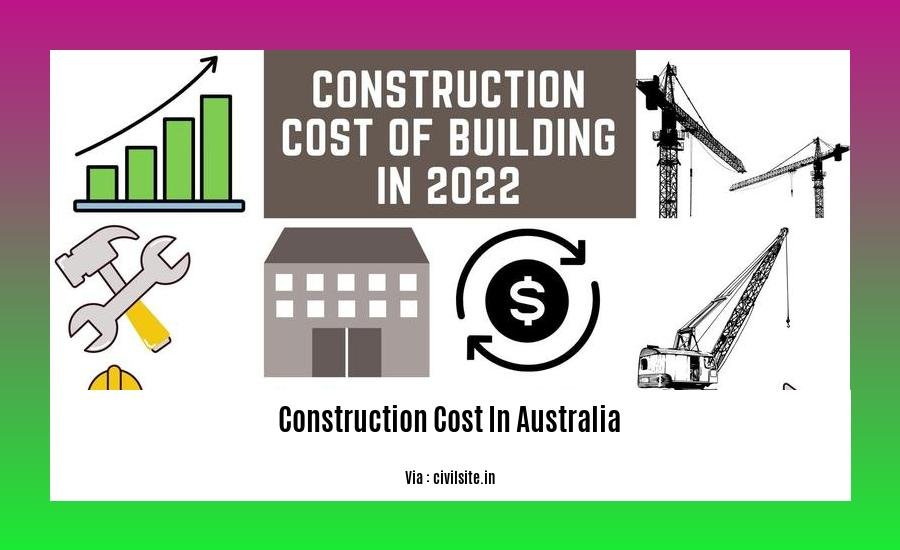Construction costs in Australia are a major consideration for project planning, with numerous factors influencing project feasibility and overall success. Various factors affect construction costs in Australia, including labor rates, material prices, regulatory compliance, and sustainability standards. Understanding these key considerations is essential for effective project budgeting and successful project delivery in the Australian construction industry.
Key Takeaways:
- The average cost to build a new home in Australia in 2022 was $473,000.
- Factors affecting cost include the size of the house, its location, and the quality of materials used.
- Building costs have increased, but the rate of increase is slowing down.
- The critical shortage of skilled labor and the collapse of building companies continue to keep costs elevated.
Construction Cost in Australia: A Comprehensive Guide

The construction cost in Australia is a crucial factor influencing project planning for homeowners, businesses, and investors. To navigate the complexities, understanding the various elements affecting these costs is essential.
Factors Influencing Construction Costs
- Labor Costs: Australia faces a critical shortage of skilled labor, driving up wages.
- Material Availability and Prices: Global supply chain disruptions have impacted material availability, resulting in increased prices.
- Construction Methods: The choice of construction methods, such as traditional or modular, can significantly affect costs.
- Geographical Location: The cost of construction varies across Australia, with urban areas typically being more expensive.
- Government Regulations: Building codes and environmental regulations can add to construction costs.
Average Construction Costs
| Building Type | Average Cost per Square Meter |
|---|---|
| Residential Home | $2,500 – $3,500 |
| Commercial Property | $2,000 – $3,000 |
| Industrial Warehouse | $1,500 – $2,500 |
Cost Estimation Techniques
Accurately estimating construction cost in Australia is crucial for project success. Common techniques include:
- Unit Pricing: Multiplying the unit cost of materials and labor by the quantity required.
- Quantity Surveying: Measuring and valuing the quantities of materials and labor involved in the construction process.
- Cost Analysis: Analyzing historical data and industry trends to estimate costs.
Cost-Saving Strategies
- Explore Alternative Materials: Consider using sustainable or recycled materials to reduce costs.
- Negotiate with Contractors: Engage in open communication and seek competitive quotes from multiple contractors.
- Hire a Project Manager: A skilled project manager can save costs through efficient planning and coordination.
Trends and Future Outlook
The construction industry in Australia is experiencing rising costs due to labor shortages and supply chain issues. However, the rate of increase is slowing. Technological advancements and government initiatives, such as the HomeBuilder grant, may offer opportunities for cost reduction in the future.
By understanding the factors influencing construction cost in Australia and applying cost-saving strategies, you can effectively plan and manage your construction projects. This will help you make informed decisions and achieve your desired outcomes within the allocated budget.
Looking for a reliable construction company in Harare? Check out construction companies in zimbabwe harare for a list of the best options.
Need help creating a compelling construction company profile? Discover construction company profile examples that will showcase your expertise and attract new clients.
If you’re in Coimbatore and seeking construction contractors, explore construction contractors in coimbatore. They offer a wide range of services to meet your construction needs.
For construction contractors in Jaipur, look no further than construction contractors in jaipur. They specialize in providing high-quality construction services for both residential and commercial projects.
Cost Estimation Techniques

Cost estimation plays a pivotal role in successful construction projects. It enables contractors and stakeholders to make informed decisions throughout the project lifecycle. A comprehensive understanding of the various Cost Estimation Techniques can help construction professionals accurately forecast and manage expenses, ensuring financial viability.
Factors that Influence Construction Costs
Numerous factors influence construction costs, including:
- Labor costs
- Material availability and prices
- Construction methods
- Geographical location
- Government regulations
Common Cost Estimation Techniques
Various techniques are employed to estimate construction costs. The most common include:
- Unit pricing: Assigning a cost per unit to each element of the project, such as per square meter for building area or per linear meter for piping installation.
- Quantity surveying: Measuring and calculating the quantities of materials, labor, and equipment required for the project, then applying unit prices or rates to estimate total costs.
- Cost analysis: Analyzing historical data and industry benchmarks to estimate project costs by comparing similar projects or components.
Cost-Saving Strategies
Careful planning and implementation of cost-saving strategies can help reduce construction costs without compromising quality:
- Explore alternative materials and suppliers.
- Negotiate with contractors to secure favorable pricing and terms.
- Hire a project manager to oversee the project and proactively identify potential cost overruns.
Trends and Future Outlook
Understanding current trends and anticipating future developments in construction costs is essential for effective project planning. While construction costs have been rising, potential cost reductions are expected from technological advancements and government initiatives aimed at promoting efficiency and sustainability.
Key Takeaways:
- Cost estimation is crucial for effective project planning and financial management.
- The most common Cost Estimation Techniques include unit pricing, quantity surveying, and cost analysis.
- Factors such as labor costs, material availability, construction methods, geographical location, and government regulations influence construction costs.
- Cost-saving strategies, such as exploring alternative materials and hiring a project manager, can help manage expenses.
- Keeping abreast of construction cost trends and anticipated developments ensures informed decision-making.
Citation
- Rawlinsons, E. E. (2024). Rawlinsons Australian Construction Handbook. Rawhouse.
Cost-Saving Strategies
Understanding Cost-Saving Measures in Construction
Understanding how to save money during construction is essential for keeping projects on track and within budget. Here are a few Cost-Saving Strategies:
-
Explore Alternative Materials: Consider using recycled or sustainable materials, which can be more cost-effective than traditional options.
-
Negotiate with Contractors: Get multiple bids and negotiate with contractors to secure the best possible price while maintaining quality standards.
-
Hire a Project Manager: A skilled project manager can streamline the construction process, reduce waste, and identify potential savings.
Key Takeaways:
- Alternative materials can offer significant cost savings.
- Negotiating with contractors is crucial for securing competitive prices.
- Hiring a project manager can optimize the construction process and reduce expenses.
Most Relevant URL Source:
– PlanRadar: https://www.planradar.com/au/maximizing-project-efficiency-6-tips-to-optimize-cost-savings-in/
Trends and Future Outlook
Construction costs in Australia are experiencing significant fluctuations due to various factors. The cost of materials, labor shortages, and global economic uncertainty are just a few of the challenges faced by the industry. Despite these challenges, the outlook for the Australian construction industry remains positive, with significant government investment in infrastructure and renewable energy projects.
To stay ahead of the curve and mitigate cost overruns, it’s essential to understand the evolving trends and future prospects of construction costs in Australia. These trends include:
- Rising Labor Costs: The scarcity of skilled labor continues to drive up wages, impacting overall project costs.
- Supply Chain Disruptions: Global supply chain issues have led to shortages and price increases for construction materials, further exacerbating cost pressures.
- Technological Advancements: Digitalization and automation are transforming the industry, offering opportunities for cost optimization and productivity gains.
- Environmental Regulations: Increasing focus on sustainability and carbon reduction is driving demand for green building materials and practices, potentially impacting construction costs.
By staying informed about these trends, construction professionals can proactively plan and strategize to manage costs effectively.
Key Takeaways:
- Construction costs are influenced by a complex interplay of factors.
- The construction industry faces challenges such as rising labor costs and supply chain disruptions.
- The industry outlook is positive, with government investment driving growth.
- Understanding trends and future prospects is crucial for cost optimization.
- Technological advancements and environmental regulations will shape the industry in the coming years.
Most Relevant URL Source:
KPMG. (2023). Global Construction Survey 2023 – Risks and Challenges. Retrieved from
FAQ
Q1: What is the average cost to construct a new home in Australia?
A1: As of 2022, the average cost to build a new home in Australia was approximately $473,000.
Q2: What factors affect the cost of construction?
A2: Factors that influence construction costs include the size of the project, its location, the quality of materials used, and the availability of skilled labor.
Q3: What methods are used to estimate construction costs?
A3: Common methods for estimating construction costs include the cost per square foot and unit pricing. Estimators consider all relevant variables to ensure accurate cost estimates.
Q4: What are some challenges facing the Australian construction industry?
A4: The industry is facing challenges such as cost inflation in materials and labor, supply chain disruptions, labor shortages, and delays due to economic uncertainty.
Q5: What are the growth sectors in the Australian construction industry?
A5: Growth sectors include transportation, utilities, and renewable energy projects due to government investment and increasing demand.
- The Best Battery Picture Lamps for Effortless Artwork Illumination - April 1, 2025
- Double Sink Bath Vanity Tops: A Buyer’s Guide - April 1, 2025
- Bath Towel Measurements: A Complete Guide to Choosing the Right Size - April 1, 2025










